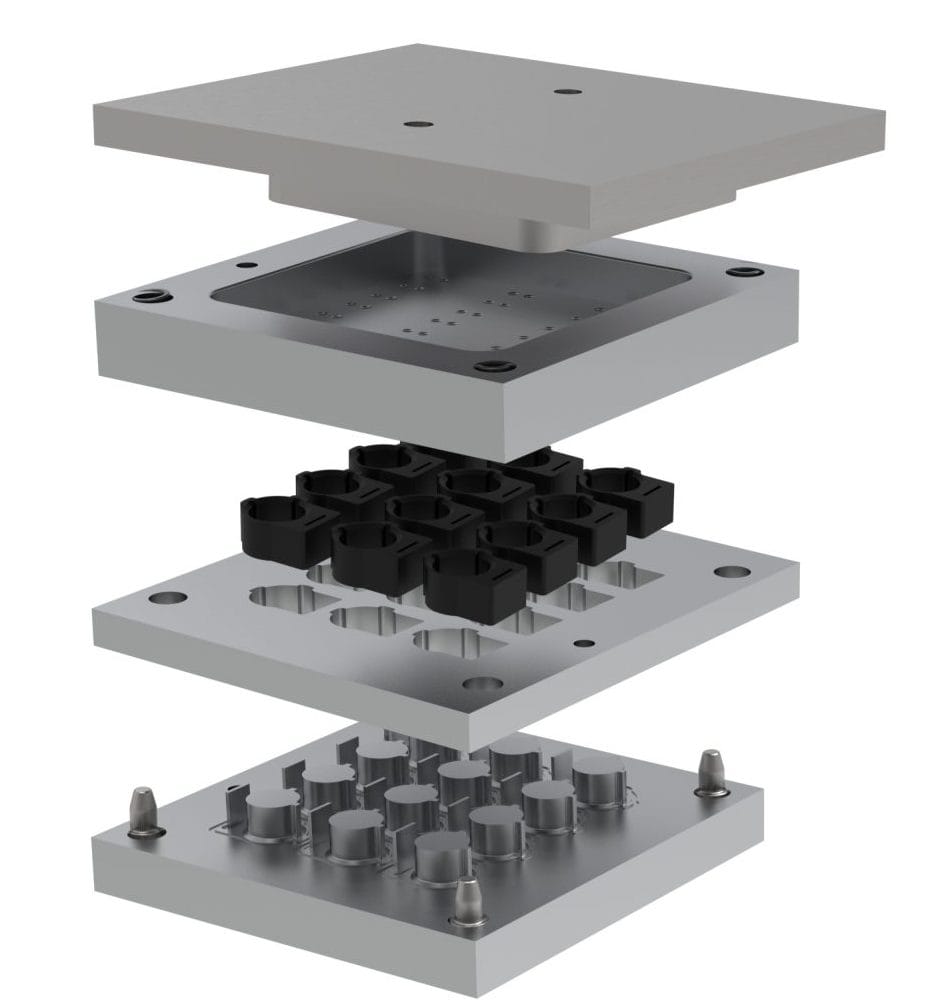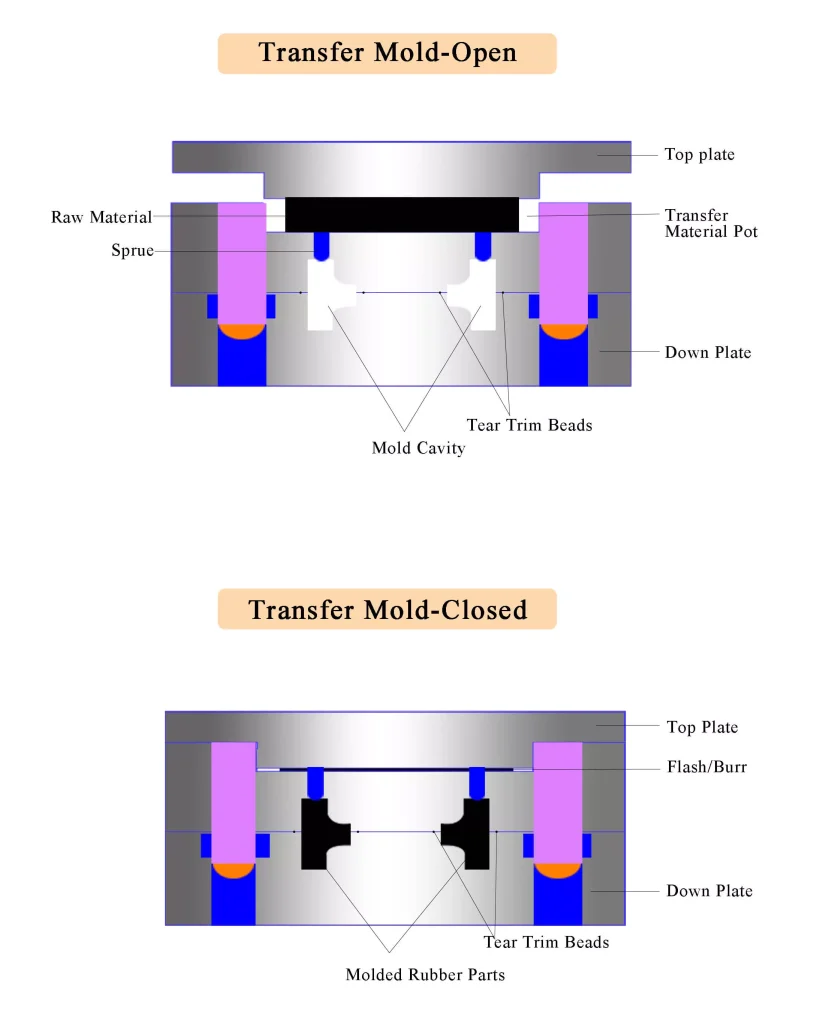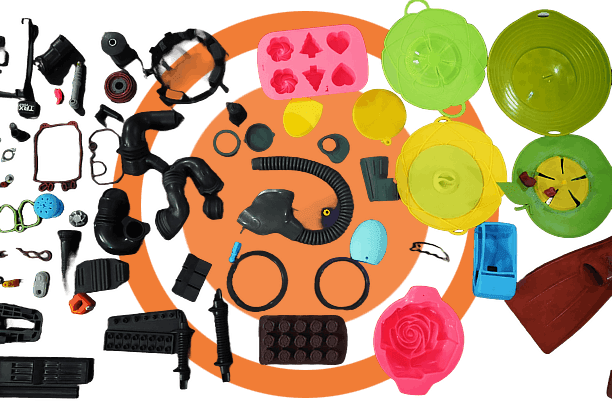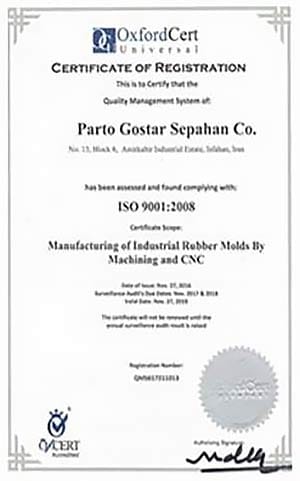Transfer Rubber Mold
The Transfer or Transfer Rubber Mold is a production process for rubber parts in which material is guided from a chamber behind the mold into the mold under pressure and heat to form the part.
Transfer rubber molds are among the most important molds used in the rubber product manufacturing industry. Due to their high efficiency, durability, and the high quality of the final product, these molds are widely used across various industries.

Advantages and Applications of Using Transfer Molds
Transfer molds are commonly used for producing rubber-to-metal parts. Compared to compression molding, the transfer method provides better material compaction, and these molds also have superior parting lines compared to compression molds. Another advantage of using transfer molds for rubber parts is the prevention of air entrapment in the mold.
Transfer rubber molds are widely used in various industries such as automotive, electronics, medical, and packaging industries.

Using these molds can help improve product quality, reduce production costs, and increase efficiency across various industries.
Ultimately, given the importance and widespread applications of transfer rubber molds, familiarity with these molds and their associated technologies is essential for manufacturers and specialists in the rubber injection industry. By leveraging the capabilities of these molds, high-quality product manufacturing and cost reduction can be achieved.
What is a Transfer Rubber Mold?
Transfer rubber molding is one of the methods for shaping rubber and elastomers, where the raw material (rubber compound) is first placed in a special chamber and then injected under pressure through channels (runners) into the mold cavity.
In fact, this method is a combination of compression molding (Compression) and injection molding, aiming to combine the advantages of both methods.
In transfer molding, the rubber material is partially preheated before entering the cavity and then injected uniformly into the mold. This process ensures high dimensional accuracy, excellent surface quality, and absence of air bubbles or surface defects.

Transfer Rubber Mold: Precision, Quality, and Durability in Rubber Part Production
In the world of industrial rubber part production, the choice of molding method plays a crucial role in the final product quality. One of the most precise and widely used methods in this field is Transfer Molding, which combines advanced technology, high accuracy, and quality control to produce parts with excellent surface finish and long-lasting durability.
In this article, we will provide a comprehensive overview of transfer rubber molds, including their concept, manufacturing process, advantages, applications, and differences compared to other molding methods.
Transfer Molding Process and Production Steps
To better understand how this mold works, we examine the steps involved in producing rubber parts using the transfer method:
Preparation of Rubber Material (Compound)
Rubber materials are first mixed and their vulcanization properties are controlled to achieve the desired mechanical characteristics.Placing Material in the Transfer Pot
The material is placed in a mass form in a chamber above the mold.Applying Pressure with a Piston or Plunger
The piston pushes the partially heated material through runners into the mold cavities under high pressure.Curing and Shaping the Part
At a specific temperature and time, the vulcanization reaction occurs, and the rubber part takes its final shape.Cooling and Ejecting the Part
After the process is complete, the mold is cooled and the final part is removed with minimal flash.
Advantages of Using Transfer Rubber Molds
Compared to other methods, transfer molding offers significant advantages, making it an ideal choice for producing precise and industrial parts:
- High dimensional and detail accuracy
Parts produced with transfer molds have precise tolerances and high uniformity. - Excellent surface quality
The uniform flow of material ensures smooth, shiny, and defect-free surfaces. - Reduced flash
Due to the special mold design, flash is minimal, reducing the need for final finishing. - Ability to produce multi-part or metal-inserted components
This method allows production of parts that include metal sections or internal reinforcements. - Suitable for high-volume production with high precision
In large quantities, production quality is maintained with excellent repeatability.
Applications of Transfer Rubber Molds in Various Industries
Transfer molds are used across different industries, especially where high accuracy and surface quality are required. Some key applications include:
- Automotive Industry
Manufacturing parts such as bumpers, packings, seals, and specific engine and brake system gaskets. - Electrical and Electronics Industries
Production of rubber insulators, bushings, and protective covers for connectors. - Oil, Gas, and Petrochemical Industries
Creating heat-resistant washers, precision O-rings, and pressure-resistant sealing components. - Medical Industry
Production of precise silicone parts, such as valves and sealing components for medical equipment. - Home Appliances and General Industrial Equipment
Manufacturing anti-vibration parts, rubber bases, and elastomeric connectors.
Difference Between Transfer, Compression, and Injection Molds
| Features | Compression Mold | Transfer Mold | Injection Mold |
|---|---|---|---|
| Production Speed | Medium | High | Very High |
| Dimensional Accuracy | Average | High | Very High |
| Mold Cost | Low | Medium | High |
| Suitable For | Simple parts | Precision and multi-part components | Mass production |
| Flash Amount | High | Low | Very Low |
As observed, the transfer mold is an optimized intermediate option between the other two methods, balancing cost, quality, and production speed.
Key Points in Designing Transfer Rubber Molds
To achieve the best results, the mold design should be precise and based on the part type and compound characteristics. Key considerations include:
- Correct selection of injection point and material flow path
- Precise design of channels and cavities for uniform distribution
- Use of heat and pressure-resistant materials for the mold body
- Incorporating a venting system for trapped gases
- Designing for easy mold opening, closing, and part ejection
Why Choosing Transfer Molds Matters
In modern industries where quality and production accuracy are paramount, using transfer molds ensures:
- Reduced material waste
- Shorter production time
- Longer mold life
- Consistently high final product quality
These advantages allow manufacturers using transfer molds to save on production costs while maintaining a competitive edge in the market.
Choosing the Best Transfer Mold Manufacturer in Iran
If you intend to order or manufacture transfer rubber molds, selecting a company with experience in mold design and machining is crucial.
A company like Pertoo Gostar Sepahan, with years of experience in designing and producing various rubber molds, can provide specialized services including 3D design, precise manufacturing, performance testing, and final mold adjustments.
Technical support, providing CAD drawings, and using high-quality raw materials in mold production are factors that make this company a reliable choice in the country’s mold-making industry.
Conclusion
Transfer rubber molding is one of the most advanced methods for producing rubber parts, combining precision, speed, and quality to meet the needs of many modern industries.
If you seek to manufacture parts where surface quality, dimensional accuracy, and high repeatability are critical, transfer molding is the best choice for you.
Using this technology not only reduces production costs but also enhances the durability and aesthetic quality of rubber products.








